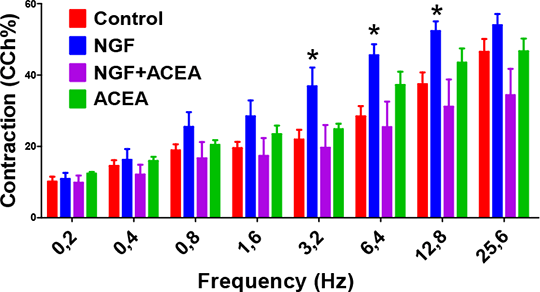Cannabinoid CB1 Receptors Modulate N erve-mediated Airway Hyperreactivity in Mouse Trachea Introduction: Airway hyperresponsiveness (AHR) is an important feature of asthma, characterised by an increased sensitivity to a great number of agents, microbes and irritants. There is still limited information about the contribution of neurogenic activity of the airways in AHR. The aim of the present study was to investigate if the selective cannabinoid CB1 receptor agonist Arachidonyl-2'-chloroethylamide (ACEA) affects the nerve-mediated cholinergic responses in the airways both directly and after nerve growth factor (NGF)-induced inflammation. Methods: The tracheal segments from male BALB/c mice were isolated, and divided into the proximal and the distal part. They were either used freshly or after four days of culturing; control, NGF (100ng/ml)-treated, ACEA (1µM)-treated and NGF+ACEA-treated. Both fresh and cultured tissues were mounted in myographs, and after a stabilization period two consecutive KCl (60mM) contractions were elicited. Then concentration-dependent (1nM-100µM) responses to carbachol and frequency-dependent (0.2-25.6Hz) responses to electrical field stimulation (EFS) (0.8ms pulse duration, 55mA, 60s train duration with 90s intervals) were investigated in isolated tracheal segments. The acute effect of ACEA (1 and 10µM) was studied on the constant (4Hz with the previous parameters) train responses on fresh and cultured tissues. EFS-induced responses were expressed as the percentage of maximum carbachol contractions and the acute effect of ACEA was expressed as percentage of the inhibition of constant trains. Data are represented as means±SEM with 5-6 observations from each group and analysed by one-way ANOVA. Results: In fresh trachea, ACEA inhibited the constant train EFS-induced contractions in both proximal (17.9±5.3% at 1µM and 34.7±5.9% at 10µM) and distal (14.5±3.5% at 1µM and 38±8.4% at 10µM) parts of the tracheas without affecting the carbachol responses. Also after four days of culture, the acute inhibitory effect of ACEA was similar in all four groups without alteration of carbachol responses. However, treatment with NGF had no effect on carbachol responses but increased the EFS responses in the proximal part of the trachea (n=6, P<0,05) which was prevented by ACEA (Fig.1). EFS responses in the distal part of the trachea were not changed after NGF treatment. 
Fig.1. Effect of NGF, ACEA and NGF+ACEA treatmenton EFS-induced contraction responses on four dayscultured proximal trachea. Conclusion: This study shows that cannabinoid CB1 receptors can acutely inhibit EFS responses by a presynaptic mechanism, and also modify neural airway reactivity induced by chronic inflammation. These findings suggest that CB1 receptors may have a preventive role in AHR in asthma. Acknowledgements: We would like to acknowledge the support from the Swedish Medical Research Council, the Swedish Heart-Lung foundation, Hacettepe University, Scientific Research Projects Coordination Unit and the Scientific and Technological Research Council of Turkey.
|


